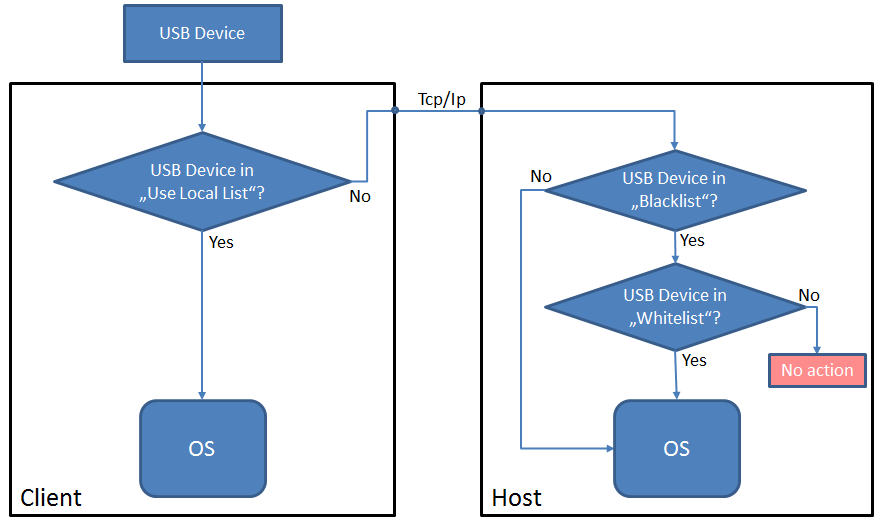USB Device Filter Lists
For each client, USB device filter lists can be configured: Blacklist, Whitelist and Use Local List (see also chapter Client configuration). Each entry in these lists represents a certain group on USB devices.
Device Blacklist
USB devices with a corresponding entry in the device blacklist are ignored by the host PC.
If "Virtual-USB" is activated and an entry exists in the blacklist for a USB device of the client, the device is not connected to the host PC via "Virtual-USB". In this case, the USB device cannot be used on the host PC or the client.
Device Whitelist
A corresponding entry in the device whitelist cancels a blacklist entry. Such a USB device is not ignored by host PC, even if a blacklist entry exists for the device.
If "Virtual-USB" is activated and entries exist for the USB device of the client both in the blacklist and in the whitelist, the whitelist entry cancels the blacklist entry. In other words, the USB device is connected to the host PC, despite the entry in the blacklist. In this way it is possible to block a certain group of USB devices, e.g. all HIDs (Human Input Devices), while allowing a certain subgroup of the blocked devices, e.g. keyboards.
Device Use Local List
USB devices with a corresponding entry in the Device Use Local List are used locally at the client.
If "Virtual-USB" is activated and a corresponding entry exists in the Use Local List for a USB device of the client, the device is not connected to the host PC via "Virtual-USB" but can be used locally at the client.
Action
For each USB device connected to a client, the device filter lists described above are used as follows:
- ▪
- Device Use Local List
The Use Local List is used at the client itself. If a suitable entry exists for the USB device, the operating system of the client is notified about the device, so that it can be used locally at the client. If no suitable entry exists for the USB device in the Use Local List, the device is connected to the host PC via "Virtual-USB".
- ▪
- Device Blacklist
If no entry exists for the USB device in the Use Local List, the blacklist is used initially. If no suitable entry exists for the USB device in the blacklist, the operating system of the host PC is notified about the device, so that it can be used at the host PC. If, on the other hand, a suitable entry does exist in the blacklist, the operating system of the host PC is not notified of the USB device, and the device whitelist is used.
- ▪
- Device Whitelist
If an entry exists for the USB device in the blacklist, the operating system of the host PC is not notified of the device, and the whitelist is used. If a suitable entry exists for the USB device in the whitelist, the operating system of the host PC is notified of the device, irrespective of the entry in the blacklist. In other words, the whitelist entry cancels the blacklist entry, and the device can be used at the host PC. If no suitable entry exists for the USB device in the whitelist, the operating system of the host PC is not notified of the device. In this case, the device can be used neither at the host PC or at the client.

